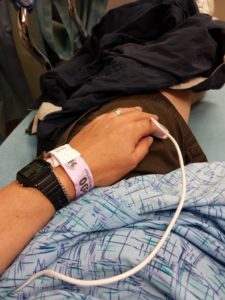Allergies to nuts, grains, vegetables, seafood and milk are common. Allergies to meat? Much less so. But that’s starting to change.
A few months ago I read about adults (author John Grisham in particular) developing an allergy to red meat after being bitten by ticks.* And not just a low-level allergy like your face turning red — we’re talking full-on hives and anaphylactic** shock, the kind of thing that requires you to carry an Epi-Pen to make sure you keep breathing long enough to reach the emergency room.
Researchers have determined that the lone star tick’s bite can cause the body to produce an IgE antibody for a sugar called alpha-gal, which is found in mammal meat.
The result: from then on, you’re allergic to meat.
CNN calls it mysterious. Allergic Living calls it baffling. It’s certainly weird compared to “usual” allergies, and the fact that the reaction is usually delayed by a few hours makes it hard to diagnose, but we’re ahead of the game in understanding it: Unlike most allergies, we know what causes this one.
With most allergies, we know the process, but we don’t know what gets the ball rolling to begin with. We know that in people who are allergic to a food, exposure to it causes an IgE antibody reaction that triggers a massive release of histamines that sends the body into some level of shock, but we don’t know why some people have that reaction and others don’t.
There are a lot of ideas being investigated, with varying amounts of supporting evidence, but there’s still nothing we can point to and say: “This caused you to be allergic to nuts” or “That caused you to be allergic to milk.” Advice to parents concerned about keeping their child from developing allergies is all over the map.
2025 Update
When I posted this back in 2012, I segued into a call for fundraising for research. The particular fundraiser has since been discontinued, but research has dramatically improved both medical understanding and practical actions around allergies.
First: it’s been clearly demonstrated that early introduction of a food lowers the risk of a child developing an allergy to it. It’s not a guarantee, but at least there’s clear advice to parents now!
Plus, immunotherapy and IgE-targeting treatments can reduce sensitivity and severity (though they can’t always eliminate reactions entirely) for those of us who already have severe allergies, those who develop allergies as adults, and the (much smaller!) percentage of children who still develop food allergies even with early exposure.
Unfortunately there’s still no clear explanation for why that ~3% of children who do have early exposure still go on to develop allergies — or why some people bitten by the lone star tick develop what is now called alpha-gal syndrome and others don’t.
Advice these days is basically: Try not to get bitten by ticks, and if you do develop the allergy, stop eating red meat.
Notes
*Naturally, this was a few days after I hiked a severely overgrown trail without taking precautions against ticks, so I freaked out a bit, but I also hadn’t found any ticks when I got home from the hike.
**Fun fact: Chrome’s spell-checker doesn’t know “anaphylactic,” and suggested such helpful alternatives as “intergalactic” and “anticlimactic.” Not sure about the former, but I get the impression a lot of viewers suffered “anticlimactic shock” when watching the Lost finale.

